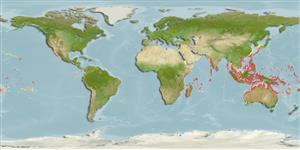>
Eupercaria/misc (Various families in series Eupercaria) >
Scaridae (Parrotfishes) > Scarinae
Etymology: Scarus: Greek, skaros = a fish described by anciente writers as a parrot fish; 1601 (Ref. 45335).
More on author: Bleeker.
Environment: milieu / climate zone / depth range / distribution range
Sinh thái học
Biển Cùng sống ở rạn san hô; Mức độ sâu 2 - 25 m (Ref. 37816). Tropical
Indo-Pacific: widespread in the Indian Ocean (Ref. 9793), ranging from East Africa south to Natal, South Africa (Ref. 5490) and east to Madagascar, Seychelles, Mauritius, Chagos Archipelago, and Maldives through the eastern Indian Ocean to French Polynesia and Pitcairn. Replaced by Scarus forsteni in most of the Pacific, with overlapping distributions in the Philippines, eastern Indonesia and Palau (Ref. 37816). Recently reported from Tonga (Ref. 53797).
Bộ gần gũi / Khối lượng (Trọng lượng) / Age
Maturity: Lm ? range ? - ? cm
Max length : 52.7 cm TL con đực/không giới tính; (Ref. 125599); common length : 17.5 cm SL con đực/không giới tính; (Ref. 9793); Khối lượng cực đại được công bố: 2.9 kg (Ref. 125599)
Các tia vây lưng cứng (tổng cộng) : 9; Các vây lưng mềm (tổng cộng) : 10; Tia cứng vây hậu môn: 3; Tia mềm vây hậu môn: 9. Males differ slightly in head pattern and differences most obvious in females with yellow or red anal fins (Ref. 48636). Terminal phase similar to S. forsteni, differing primarily by having a yellow inner pectoral axil (Ref. 37816).
Inhabits lagoon and seaward reefs, in areas with dense coral growth (Ref. 9710) up to at least 30 m. Usually solitary, sometimes in groups (Ref. 9710). Feeds on benthic algae (Ref. 3488).
Life cycle and mating behavior
Maturities | Sự tái sinh sản | Spawnings | Egg(s) | Fecundities | Ấu trùng
Oviparous, distinct pairing during breeding (Ref. 205).
Randall, J.E. and J.H. Choat, 1980. Two new parrotfishes of the genus Scarus from the Central and South Pacific, with further examples of sexual dichromatism. Zool. J. Linn. Soc. 70:383-419. (Ref. 2689)
IUCN Red List Status (Ref. 130435)
Threat to humans
Harmless
Human uses
Các nghề cá: Tính thương mại; Bể nuôi cá: Tính thương mại
Các công cụ
Special reports
Download XML
Các nguồn internet
Estimates based on models
Preferred temperature (Ref.
123201): 24.9 - 29.3, mean 28.4 °C (based on 3096 cells).
Phylogenetic diversity index (Ref.
82804): PD
50 = 0.5000 [Uniqueness, from 0.5 = low to 2.0 = high].
Bayesian length-weight: a=0.01778 (0.01082 - 0.02921), b=3.06 (2.93 - 3.19), in cm total length, based on LWR estimates for this species & Genus-body shape (Ref.
93245).
Mức dinh dưỡng (Ref.
69278): 2.0 ±0.0 se; based on diet studies.
Thích nghi nhanh (Ref.
120179): Trung bình, thời gian nhân đôi của chủng quần tối thiểu là 1.4 - 4.4 năm (Preliminary K or Fecundity.).
Fishing Vulnerability (Ref.
59153): Moderate vulnerability (41 of 100).
Nutrients (Ref.
124155): Calcium = 51.9 [33.6, 86.3] mg/100g; Iron = 0.833 [0.578, 1.274] mg/100g; Protein = 18.5 [16.5, 20.3] %; Omega3 = 0.094 [0.064, 0.138] g/100g; Selenium = 16.9 [10.4, 26.6] μg/100g; VitaminA = 59.4 [18.4, 194.3] μg/100g; Zinc = 2.51 [1.91, 3.27] mg/100g (wet weight); based on
nutrient studies.
